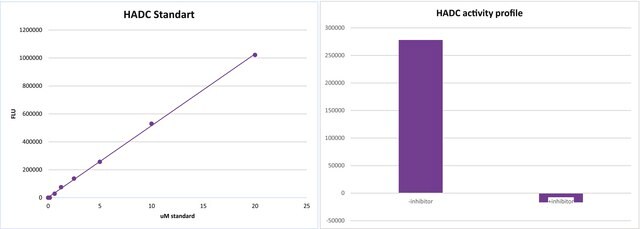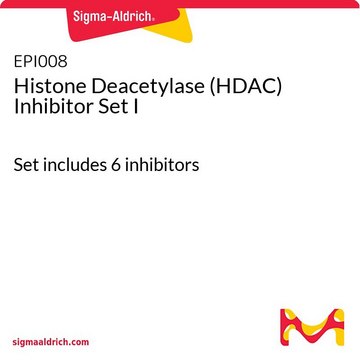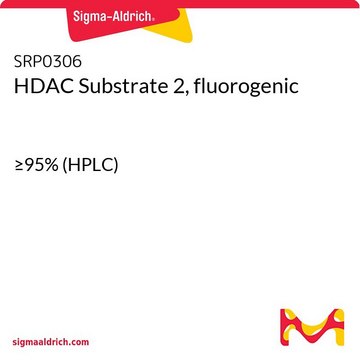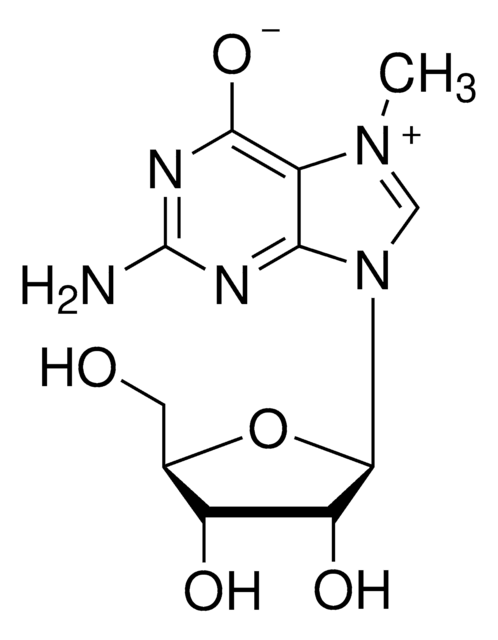EPI003
In Situ Histone Deacetylase (HDAC) Activity Fluorometric Assay Kit
100 assays in 96 well plates
Faça loginpara ver os preços organizacionais e de contrato
About This Item
Produtos recomendados
uso
100 assays in 96 well plates
Condições de expedição
wet ice
temperatura de armazenamento
−20°C
Descrição geral
Histone deacetylases (HDACs) are a large family of enzymes that remove acetyl groups from histone proteins. HDACs are localized in both the cytosol and nucleus and some shuttle between the two locations.
Sigma′s InSitu HDAC Activity Fluorometric Assay Kit provides a direct, fast, fluorescence-based method to measure HDAC activity in cultured cells. The procedure requires just two steps, both performed in the original 96-well cell culture plate. First, the cell culture medium is replaced with a cell permeable HDAC Substrate, containing an acetylated lysine side chain. During the subsequent incubation, HDAC Substrate enters the cells and is deacetylated by intracellular HDAC. In the second step, Developer is added to lyse the cells and cleave the deacetylated HDAC Substrate to release a fluorophore. The fluorescence generated can be quantified at Ex/Em = 368/442 nm. The assay is well suited for either individual or high throughput screening.
Sigma′s InSitu HDAC Activity Fluorometric Assay Kit provides a direct, fast, fluorescence-based method to measure HDAC activity in cultured cells. The procedure requires just two steps, both performed in the original 96-well cell culture plate. First, the cell culture medium is replaced with a cell permeable HDAC Substrate, containing an acetylated lysine side chain. During the subsequent incubation, HDAC Substrate enters the cells and is deacetylated by intracellular HDAC. In the second step, Developer is added to lyse the cells and cleave the deacetylated HDAC Substrate to release a fluorophore. The fluorescence generated can be quantified at Ex/Em = 368/442 nm. The assay is well suited for either individual or high throughput screening.
Aplicação
In Situ Histone Deacetylase (HDAC) Activity Fluorometric Assay Kit has been used to determine HDAC activity.
Ações bioquímicas/fisiológicas
Site specific histone acetylation and deacetylation have been shown to activate or repress eukaryotic gene transcription, respectively, and as a consequence, histone deacetylases (HDACs) play a crucial role in organism development and disease. Mutation or abnormal expression of HDAC is observed in cancer.
Características e benefícios
- Simple two-step sensitive and reliable assay
- All steps performed in the same cell culture plate
- Utilizes fluorometric method
- Sample type: cultured, adherent, and suspension cells
- Suitable for individual tests or high throughput assays and kinetic studies
- Convenient 96-well microplate format
- Suitable for screening HDAC inhibitors or activators
- Suitable for studying growth factors or other regulators that influence HDAC activity
produto relacionado
Nº do produto
Descrição
Preços
Palavra indicadora
Warning
Frases de perigo
Declarações de precaução
Classificações de perigo
Aquatic Chronic 3 - Eye Irrit. 2
Código de classe de armazenamento
10 - Combustible liquids
Ponto de fulgor (°F)
188.6 °F - closed cup
Ponto de fulgor (°C)
87 °C - closed cup
Escolha uma das versões mais recentes:
Certificados de análise (COA)
Lot/Batch Number
Não está vendo a versão correta?
Se precisar de uma versão específica, você pode procurar um certificado específico pelo número do lote ou da remessa.
Já possui este produto?
Encontre a documentação dos produtos que você adquiriu recentemente na biblioteca de documentos.
Covalent modifications of histones during development and disease pathogenesis.
Bhaumik S R, et al.
Nature Structural and Molecular Biology, 14(11), 1008-1008 (2007)
The biology of HDAC in cancer: the nuclear and epigenetic components.
Handbook of Experimental Pharmacology, 206, 13-37 (2011)
Targeting histone deacetylase activity to arrest cell growth and promote neural differentiation in Ewing sarcoma.
Souza B K, et al.
Molecular Neurobiology, 1-17 (2018)
Christina Stache et al.
Neurosurgical focus, 41(6), E14-E14 (2016-12-03)
OBJECTIVE In this study, the authors investigated the underlying mechanisms responsible for high tumor recurrence rates of adamantinomatous craniopharyngioma (ACP) after radiotherapy and developed new targeted treatment protocols to minimize recurrence. ACPs are characterized by the activation of the receptor
Long Jin et al.
Theriogenology, 87, 298-305 (2016-10-16)
Cloning remains as an important technique to enhance the reconstitution and distribution of animal population with high-genetic merit. One of the major detrimental factors of this technique is the abnormal epigenetic modifications. MGCD0103 is known as a histone deacetylase inhibitor.
Nossa equipe de cientistas tem experiência em todas as áreas de pesquisa, incluindo Life Sciences, ciência de materiais, síntese química, cromatografia, química analítica e muitas outras.
Entre em contato com a assistência técnica








